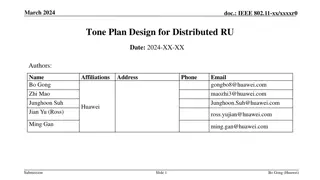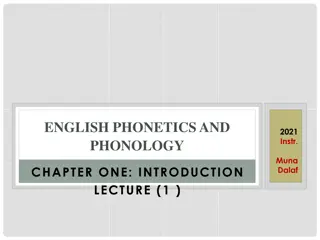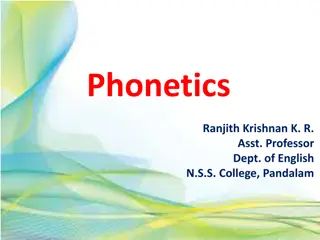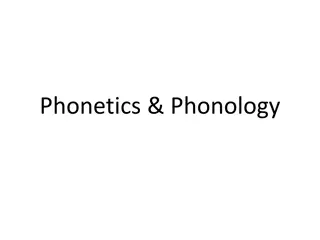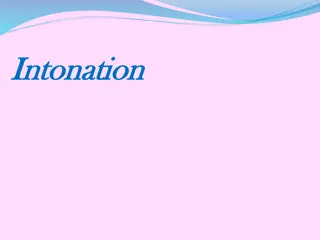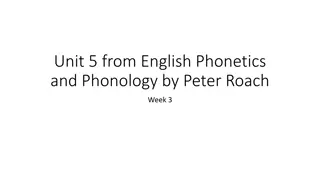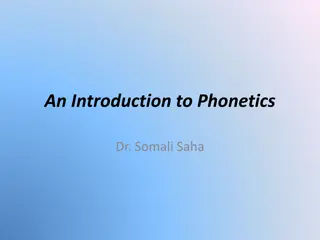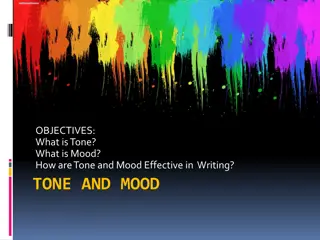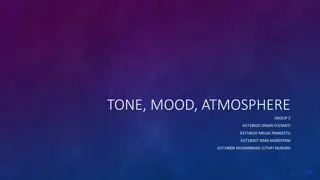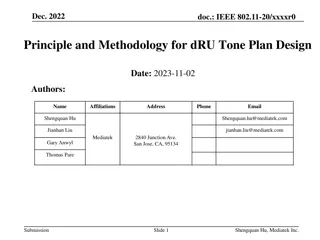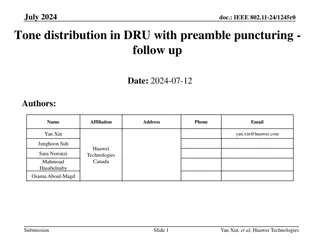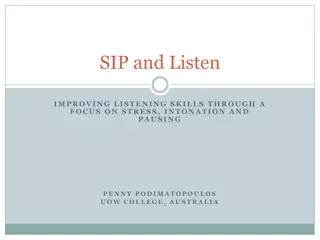Understanding Intonation and Tone in Phonetics
Intonation and tone play crucial roles in conveying meaning and expression in spoken language. Intonation refers to the melodic pattern of speech that can indicate various emotions or grammatical functions, while tone represents the pitch, quality, and strength of vocal sounds within words. By mastering the distinctions between intonation and tone, speakers can effectively communicate diverse messages through their speech patterns.
Uploaded on Mar 22, 2024 | 4 Views
Download Presentation

Please find below an Image/Link to download the presentation.
The content on the website is provided AS IS for your information and personal use only. It may not be sold, licensed, or shared on other websites without obtaining consent from the author. Download presentation by click this link. If you encounter any issues during the download, it is possible that the publisher has removed the file from their server.
E N D
Presentation Transcript
Intonation 2 and Functions of Intonation Chapters 16-18-19 Subject Lecturer: Alaa Nawzad Awla Assistant Lecturer M.A holder Course s name: Phonology 1stWeek of April
Table of contents What is intonation and tone? 1. What is a relationship between intonation and tone? 2. What is intonation language? 3. What is a tone-unit? 4. What is a difference between tone and intonation languages? 5. What is the structure of tone-unit? 6. What are some pitch possibilities in tone-unit? 7. What are the different functions of intonation? 8. What are the components of intonation? 9.
What is intonation? What is tone? Intonation, in phonetics, is the melodic pattern of an utterance. It conveys differences of expressive meaning (e.g., impression of finality, impression for saying more, showing limited agreement, showing surprise, anger, delight, or showing that you are bored or not interested), and it can also serve a grammatical function and many other functions. Intonation is a term used to refer to the distinctive use of different patterns of pitch that carry meaningful information. When we speak, normally the pitch of our voice is constantly changing. Intonation distinguishes one type of sentence from another. The different intonations a person can use to say, The cup of water is over there demonstrate this grammatical function: when a person begins with a medium pitch and ends with a lower one (falling intonation), this sentence is a simple assertion, but when a person uses a rising intonation (high final pitch), it is a question. Intonation patterns denote how an individual lowers and raises their voices depending on the message they are conveying.
What is the difference in the way the following two sentences sound? He is going tomorrow. He is going tomorrow? Answer: The melodies of the two sentences are different: The melody of sentence A drops at the end, making it a statement. The melody of sentence B rises at the end, making it a question. In languages like English, we call these sentence melodies intonations. All spoken languages have intonations.
Tone: is vocal sound with reference to its pitch, quality, and strength. It is the overall behavior of a pitch; it is the different changes or movements the pitch can show in a syllable. Example: A: I have heard that Mary is a good girl. B: No Tone is the direction of the pitch movement. We have five main tones a pitch can make. Tone and Intonation are two types of pitch variation, which are used by speakers of all languages in order to give shape to utterances. More specifically, tone encodes segments and morphemes, and intonation gives utterances a further discoursal meaning that is independent of the meanings of the words themselves. Intonation is the rise and fall of the voice in speaking while tone is the pitch of a word. While intonation uses pitch to change meaning on the sentence level, tone uses pitch in every single word. Tone refers to the emotion and attitude one puts behind their words. In contrast, intonation refers to the fluctuation of one s voice as they speak. Examples of tone languages are Japanese, Mandarin, Thai, Swedish and Cantonese. On the contrary, the majority of the rest of the world s languages are classified as intonation languages that use pitch semantically like English, German, Spanish, and French.
Intonation is basically a sequence of pitch levels across words (any parts of the words). There might be intonation on all words of an utterance. An intonational unit bundles together words into information chunks to convey meaning and attitude. Tone is basically a sequence of pitch across syllables ONLY. One Utterance has only one Tone.
Consider this example: It is me, Tom. This sentence is ambiguous! (It carries two meanings) 1. The speaker s name is Tom. (It is me, Tom.) 2. The addressee s name is Tom. (It is me, Tom!) With the first meaning, there is a pause between me and Tom ..so, we have two intonation groups; which means we have two utterances that is why we have two tonic-units (tonic syllables). However, in the second interpretation, there is one intonation group; the entire utterance has only one intonation group and the tonic syllable is me.
An intonation group is a word or sequence of words that forms an intonational unit, and this unit contain a tonic syllable. Tonic syllable is the syllable in an intonation group on which the pitch changes. Intonation is used to communicate personal attitude (meaning; sarcasm, surprise, anger .), consider these two sentences: 1. 2. He is going, isn t he? He is going, isn t he! Many of the world's languages are tone languages, in which substituting one distinctive tone for another on a particular word or morpheme can cause a change in the dictionary meaning of that word or morpheme, or in some aspect of its grammatical categorization. English language does not use tone in this way. Tone changing is used for other purposes. English uses tone for the purpose of giving extra meaning to sentences that is why English is called intonation language not tone language.
Lets practice the five English tones: It is good. 1. Falling tone to end a conversation 2. Rising tone to make something continue 3. Fall-rise tone limited agreement 4. Rise-fall tone showing strong feelings 5. Level tone saying something routine
Different pitch patterns do not alter the word in the way that changing a consonant or changing a vowel does. These different pitch patterns that do not change but merely add to the basic meaning of words are called intonation. In tone languages the main suprasegmental contrastive unit is the tone, which is usually linked to the phonological unit that we call the syllable. It could be said that someone analyzing the function and distribution of tones in a tone language would be mainly occupied in examining utterances syllable by syllable, looking at each syllable as an independently variable item. If English were spoken in isolated monosyllables, the job of tonal analysis would be a rather similar one to that described for tone languages. However, when we look at continuous speech in English utterances we find that these tones can only be identified on a small number of particularly prominent syllables. A tone-unit: is grater in size than a syllable. In its smallest form, it consists of only one syllable, so it would definitely be wrong if we say it is always composed of one syllable.
A tone-unit is a group of words forming a distinctive unit in an utterance, containing a nucleus and optionally one or more other syllables before and after the nucleus that carries an intonation with a complete pitch movement. It is a stretch of speech uttered under a single coherent intonation contour. It tends to be marked by a pause. Examples: 1. Bob went to the /park (In this sentence park is the tonic syllable because the basic rule for determining the tonic syllable in English is the last lexical item in the clause. Words Bob and went can also be the tonic syllables depending on how we utter the sentence and what words we put emphasis on to change the semantic meaning of the sentence.) 2. Is it /you (The third syllable is more prominent than the other two and carries a tone. It is called tonic syllable, so it is said on the rising tone. The other two syllables will normally be much less prominent, and be said on a level pitch. It is an utterance of three syllables, consisting of one tone-unit. Tonic syllables have a high degree of prominence; prominence is, of course, a property of stressed syllables, and a tonic syllable not only carries a tone but also a type of stress that will be called tonic stress.)
The 2ndsentence can be extended: John is it /you A fall-rise tone is used quite commonly in calling someone s name. If there is a clear pause (silence) between vJohn and is it /you , then, according to the definition of an utterance, there are two utterances; however, it is quite likely that a speaker would say vJohn is it /you with no pause, so that the four syllables would make up a single utterance.
The Structure of the Tone-unit We break up spoken language into tone units because we need to breathe, and so there is a physical reason. There is also the need to think. While we are speaking one tone unit, we are planning the next one, and so the tone unit carries only one idea at a time. Thus the pace of the tone units, and the information they convey, matches the speaker s thoughts. The faster a person speaks, the longer and the fewer the tone-units would get. Like the syllable, the tone-unit has a fairly clearly internal structure. Each tone-unit has one and only one tonic syllable; this means that the tonic syllable is an obligatory component of the tone-unit. Each tone-unit consists of only one tonic syllable, head, pre-head, and tail. (pre-head) (head) tonic syllable (tail) (PH) (H) TS (T)
One tone-unit consists of the following components: 1. One tonic syllable (which is an obligatory component) 2. Head (A head is all of that part of a tone-unit that extends from the first stressed syllable up to, but not including, the tonic syllable). 3. Pre-head (A pre-head is composed of all the unstressed syllables in a tone- unit preceding the first stressed syllable that is the head). 4. Tail (Any syllables between the tonic syllable and the end of the tone-unit are called the tail).
Pitch Possibilities in the tone-unit Because tone is carried by the tonic syllable, this tonic syllable would act as a source from which a pitch movement starts from. Thus, intonation is carried by the tone-unit. The tonic syllable is the syllable on which the pitch movement of the tone begins, but that pitch movement is completed over the rest of the tone-unit (the tails). In a tone-unit of more than one syllable, the tonic syllable must have one of the five tones. If the tonic syllable is the final syllable, the tone will not sound much different from that of a corresponding one-syllable tone-unit. Example: 'here' will be said in much the same way in the following two utterances: /here 'shall we 'sit /here However, if there are other syllables following the tonic syllable (i.e. there is a tail), we find that the pitch movement of the tone is not completed on the tonic syllable. If a tail follows a tonic syllable that has a rising tone, it will almost always be found that the syllable or syllables of the tail will continue to move upwards from the pitch of the tonic syllable.
If the word 'what' is said on a rising tone, '/what' it might have a pitch movement that could be diagrammed like this: The four syllables in '/what did you say' might be said like this: We find a similar situation with the falling tone. On a single syllable '\why', the pitch movement might be of this sort: But if there are syllables following, the fall may not be completed on the tonic syllable: \why did you -go
Exercises! Exercises! Identify the structure of the tone-units in the following sentences: 1. I will report you to the headmaster soon. 2. I have spoken with the cleaner. 3. Where is the \pencil? 4. In seconds go and see a /doctor! 5. Do you take cream in your coffee in the mornings? 6. I am taking up /taxidermy this autumn. 7. If I helped you, would you try again? 8. Despite its drawbacks, do you still /favor it or not? 9. It is a bit /too good to be true, /isn t it? 10. Ann said she would help as much as she /could naturally. 11. She is 28 years _old and lives in _Taiwan. 12. Everybody sits and /waits in the shade of the trees while the family begins to wake up and move off.
What would be lost if we were to speak without intonation? What difference can be felt?
Every syllable said on the same level pitch. No pauses No changes in speed and loudness Such would be speech produced by the mechanical speech device. Therefore, intonation easier for the listener to understand the meaning a speaker is trying to convey. makes it
What are the Functions of Intonation? There are mainly four functions of intonation: 1) Attitudinal function 2) Accentual function 3) Grammatical function 4) Discourse function
1. The Attitudinal Function Intonation enables us to express emotions and attitudes as we speak, and this adds a special kind of "meaning" to spoken language. For example, the same sentence can be said in different ways, which might be labelled Finality, questions, listing, more to follow, encouraging, irony, doubt, requesting, surprise, being impressed, angry, happy, grateful, bored...etc. A major factor in this is the tone used. This is often called the attitudinal function of intonation. 1. Falling tone - That is the end of the \news (Finality) 2. Rising tone - It wont /hurt (Encouraging) 3. Fall-rise tone - You may be right (Uncertainty) 4. Rise-fall tone - All of them (being impressed) 5. Level tone - I love the shirt in _red, blue and purple (listing something)
2. The Accentual Function When it is said that intonation has accentual function, it implies that the placement of stress is somewhat determined by intonation. In this case, intonation works to focus attention on a particular lexical item or syllable. This has been called the accentual function of intonation. It is frequently said that the placement of the tonic syllable indicates the focus of the information. For the purpose of emphasis we may place the tonic stress in different positions in the tone-unit to mean different things; in these examples, (1) is non-emphatic and (2) is emphatic: 1. It was 'very \boring 2. It was \very boring 1. You 'must not 'talk so \loudly 2. You \ must not talk so loudly
3. The Grammatical Function Intonation helps in recognizing the grammar and syntactic structure of what is being said; for example, such things as the placement of boundaries between phrases, clauses or sentences, the difference between questions and statements. This has been called the grammatical function of intonation. Sentences which when written are ambiguous, and ambiguity can only be removed by different intonation: Example: Those who sold quickly | made profit. Those who sold |quickly made profit. (A profit was made by those who sold quickly) (A profit was quickly made by those who sold)
4. The Discourse Function Intonation can signal to the listener what is to be taken as "new" information and what is already "given", can suggest when the speaker is indicating some sort of contrast or link with material in another tone-unit and, in conversation, can convey to the listener what kind of response is expected. Such functions are examples of intonation's discourse function. Example: A: Have you got any free time this /morning? B: I might have later on if that meeting's /off. A: They were talking about putting it \later. B: You can't be sure. The sentences contain several references that presuppose shared knowledge (e.g. 'that meeting' implies that both speakers know which meeting is being spoken about), and in some cases the meaning of a sentence can only be correctly interpreted in the light of knowledge of what has preceded it in the conversation (e.g. 'You can't be sure').
Consider this example: 'Since the last time we met | 'when we 'had that 'huge dinner | I ve been on a \diet The first two tone-units present information which is relevant to what the speaker is saying, but which is not something new and unknown to the listener. The final tone-unit, however, does present new information. Writers on discourse intonation have proposed that the falling tone indicates new information while rising (including falling-rising) tones indicate "shared" or "given" information.
The Components of Intonation Intonation is composed of three components: 1. o Components never occur simultaneously o They are pre-head, head, tonic syllable, tail o Pauses o Tone-unit boundaries Sequential component: 3. Paralinguistic component: o Facial expressions, gestures, body language o Vocal effects laughs, sobs, ... 2. Prosodic component: includes characteristics of speech that are constantly present while the speech is going on: Width of pitch range Loudness Speed Voice quality
Exercises! Exercises! In the following bits of conversation, you are supplied with an "opening line" and a response that you must imagine saying. You are given an indication in brackets of the feeling or attitude expressed, and you must mark on the responses the tone levels you think is appropriate. 1. It 'looks 'nice for a \swim its rather cold (doubtful) 2. 'Why not 'get a /car because I can t afford it (impatient) 3. I ve .lost my \ ticket you re silly then (stating the obvious) 4. You 'cant 'have an 'ice \cream oh please (pleading) 5. 'What 'times are the /buses seven o clock seven thirty and eight (listing) 6. She got 'four \A-levels four (impressed) 7. 'How much \work have you .got to-do I ve got to do the shopping (and more things after that...) 8. 'Will the children -go some of them might (uncertain)


